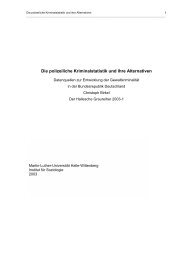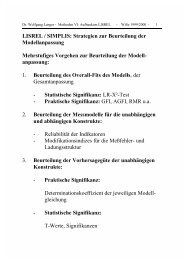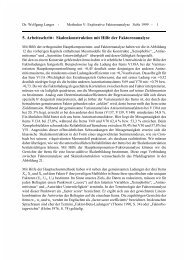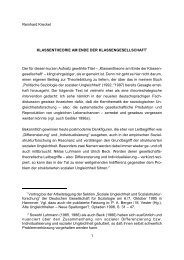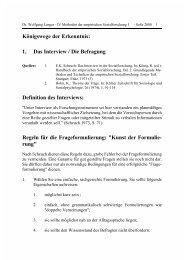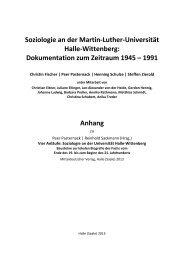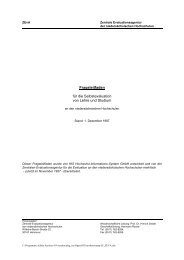EXPLAINING SOCIAL EXCLUSION - Institut für Soziologie
EXPLAINING SOCIAL EXCLUSION - Institut für Soziologie
EXPLAINING SOCIAL EXCLUSION - Institut für Soziologie
Create successful ePaper yourself
Turn your PDF publications into a flip-book with our unique Google optimized e-Paper software.
International Journal of Sociology and Social Policy 92<br />
Unemployment and social mobility in East Germany<br />
by Reinhold Sackmann, Professor, EMPAS, University of Bremen,<br />
Michael Windzio, PD, EMPAS, University of Bremen and Matthias<br />
Wingens, PD, University of Bremen<br />
High unemployment rates are still a major problem faced by many<br />
European societies; the Situation is especially grave during the transition<br />
process from a communist to a market economy. We know that unemployment<br />
has effects on the psychological well-being of persons<br />
affected (Kieselbach 2000) and on the functioning of communities hit<br />
by a high concentration of unemployment (Jahoda, Lazarsfeld and<br />
Zeisel 1971). However, our knowledge with regard to the long-term effects<br />
of unemployment on careers is rather limited. Some authors conclude<br />
that unemployment is only a transition phase in the life course<br />
and has a limited effect on long-term careers (Mutz et al. 1995). In contrast,<br />
other authors argue that unemployment is a first step towards<br />
processes of social exclusion, featuring unemployment äs a major<br />
mechanism of disintegrating certain groups from Society (Kronauer,<br />
Vogel and Gerlach 1993). Major social policy interventions fostering<br />
workfare instead of welfare äs well äs programs focussing on employability<br />
build on this kind of social diagnosis.<br />
The effects of youth unemployment on careers may be even<br />
more crucial. Youth unemployment in transition societies is seen äs a<br />
critical life event, because long-term effects of unemployment may not<br />
only leave a "scar" on the careers of the individuals (OECD 1998) but<br />
can also be a cause of major social problems in transition societies, e.g.<br />
criminal behaviour and, or racist behaviour, destabilising the fragile<br />
equilibrium of accelerated social change in transition societies.<br />
Thus, there is a need for empirical research on the long-term effects<br />
of unemployment. Methodologically, longitudinal analysis, especially<br />
event history analysis, was a major improvement for the study of<br />
the connection of life courses and social change. The aim of this article<br />
is to look into the long-term effects of unemployment on social mobility,<br />
using longitudinal data on young East Germans during the transition<br />
period. In order to simultaneously pursue transitions and<br />
Volume 21 Number 4/5/6 2001 93<br />
trajectories, two methods are used: event-history and optimalmatching<br />
analysis.<br />
Data set<br />
For the empirical analysis of the East German Career Study, a longitudinal<br />
data set of young East German labour market entry cohorts is<br />
used, which was set up at the Special Collaborative Centre 186. The<br />
data set (Weymann, Sackmann and Wingens 1999) consists of 3776<br />
young skilled workers who participated in an apprenticeship and<br />
young university graduates, all taking exams in 1985 (before the transformation),<br />
in 1990 (the reunification year) and 1995. The data set is<br />
not representative for all young people in East Germany, but only for<br />
the two most numerous qualification levels: young skilled workers and<br />
Professionals. Thus we restrict generalisations of our results to these<br />
groups. For questions of exclusion, you have to take into account that<br />
the "unqualified" are not part of the sample. However, the "unqualified"<br />
make up a very small group in East Germany, äs they only account<br />
for 3% of the cohort of young people.<br />
Theoretically, we take a dynamic approach to the phenomenon<br />
of exclusion. Cross-sectional data on unemployment can be misleading,<br />
äs they suggest that uniform levels of unemployment refer to a<br />
constant group of the unemployed. Longitudinal studies that use life<br />
event analysis have improved the dynamic analysis of unemployment.<br />
Studies usually focus on processes that cause the selectivity of becoming<br />
unemployed and processes causing exit from unemployment. Research<br />
results from this method suggest that unemployment is a<br />
transient position (Mutz et al. 1995). While results gained with this<br />
method fürthered unemployment research, it also has some blind<br />
spots. If one only looks at single transitions of unemployment, one can<br />
miss its long-term effects. The starting point of our analysis is to look<br />
into the long-term effects of unemployment for careers. To get an answer<br />
to this question, we use two methods: a) we use event-history<br />
analysis to see how unemployment (äs a time-dependent variable) influences<br />
processes of social mobility; b) we use the relatively new<br />
method of optimal matching analysis to find patterns of careers.






